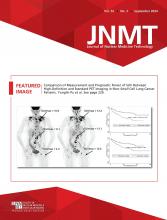Visual Abstract
Abstract
The radiation exposure of the hands of nuclear medicine laboratory technicians is largely due to the dispensing of radiopharmaceuticals into syringes. To reduce this exposure, a multiradionuclide automatic dispensing system (ADS) for syringes of radiopharmaceuticals was introduced. The aim of this study was to determine the effect of this ADS on hand dose compared with manual dispensing. Methods: The total hand dose per month for all personnel (12 technicians) was measured with ring dosimeters at the base of the index finger for 13 mo: 7 mo with manual syringe dispensing (radiopharmaceuticals containing 99mTc,18F, 177Lu, 68Ga, 90Y, and 223Ra) and 6 mo with ADS (automatic: radiopharmaceuticals containing 18F and 177Lu; manual: radiopharmaceuticals containing 99mTc, 68Ga, 90Y, and 223Ra). Results: The mean total hand dose per month was reduced from 52.8 ± 10.2 mSv with manual dispensing to 21.9 ± 2.7 mSv with ADS (P < 0.001), which is an absolute decrease of 59%. Meanwhile, the total handled activity increased from 369 to 505 GBq (P < 0.001). 18F-containing radiopharmaceuticals were the most commonly dispensed, at 182 GBq per month. The increase in total handled activity was largely due to an increase in 177Lu (from 25 to 123 GBq), partially because of the introduction of [177Lu]Lu-PSMA-I&T. When correcting for this increase in handled activity, the hand dose was reduced by 69%. Conclusion: The introduction of a multiradionuclide syringe ADS decreased the hand dose to personnel by 69% when corrected for the increase in handled activity. Expanding the number of radiopharmaceuticals being dispensed by the system could potentially further decrease personnel hand dose.
Footnotes
Published online Jun. 20, 2024.
This article requires a subscription to view the full text. If you have a subscription you may use the login form below to view the article. Access to this article can also be purchased.
SNMMI members
Login to the site using your SNMMI member credentials
Individuals
Login as an individual user








